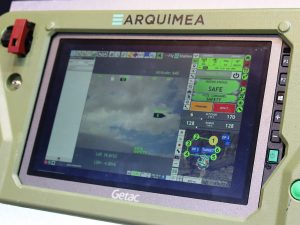
IDEX 2023: Arquimea exhibits its full Q-SLAM-40 loitering munition system
Unveiled at FEINDEF 2021 and named QLM-40, at IDEX 2023 Arquimea of Spain exhibited for the first time the renamed Q-SLAM-40 loitering munition system in its entirety, which includes the munition, the launcher, and the ground station with communications and control elements.
Shortly after the Spanish exhibition, in December 2021 the company won the bid with the Spanish MoD, which provided full support for the final development stage of the loitering munition that had been under development for seven years. The final work was carried out by Arquimea technicians hand in hand with MoD experts, in order to adapt it to Spanish Army requirements. The whole system was demonstrated in front of Army officials on October 22, 2022 in Toledo, the Q-SLAM-40 performing a successful fly and hit mission.
Comparing the 2021 and the latest version of the data sheet, apart the new name many data have changed. EDR On-Line understood that the airframe has been optimised, adopting a different fuselage diameter, the length being increased from 720 to 830 mm. The body remains all-composite, made of fibreglass/epoxy and carbon fibre to ensure high resistant to impact, while the wing remains the same, with a triple compound structure and a 1.4 meters span. The architecture is also unchanged, with front wings hinged on top of the fuselage and folded backwards while rear ones are hinged under the fuselage and folded forward, the two vertical stabilisers at the rear being tilted forward, with the two blades of the pushing propeller activated by the electric motor are folded rearward.
The munition is loaded in the pneumatic launcher, an air compressed bottle providing the required launch energy that allows the airframe to reach sufficient speed, open its aerodynamic surfaces and activate the pushing propeller. The launcher can be used for a number of operations, no exact figures being provided, while a single bottle is sufficient for three launches.
The whole system weighs 28 kg and is carried by a two-man team. One of them carries two munitions while the second carries the launcher, the antenna and radio link and the tablet-based ground control station.
Empty mass and maximum take-off mass remain the same, respectively 3.1 kg and 4.2 kg, as well as the 1 kg payload; Arquimea told EDR On-Line that a weight saving operation was carried out on the airframe, saved weight being probably invested in some improvements considering the no-change in weights.

The new airframe brings with it some considerable improvements in performances. Endurance is increased from 12 to 15 minutes (+25%), while range is more than double, from 6 to 15 km, depending on meteo conditions and orography. Cruise speed range is now 72-90 km/h, while loitering speed is increased from 62 to 72 km/h. Arquimea provides now the attack speed, in the diving phase, which is of 126 km/h. While typical operating altitude remains between 20 and 200 meters, maximum launch altitude being also unchanged at 2,000 meters, ceiling is increased to 2,800 meters. Maximum wind conditions are also slightly improved, from 32 to 35 km/h.
While GNSS navigation is standard, the Q-SLAM-40 can operate in GNSS-denied scenarios as it can be remotely operated thanks to the two-way high-speed data link operating in the 2.4 GHz band. Four types of warheads are proposed, two of them operational, one HE fragmented, and one HE
Anti-Tank, an inert and a training warhead being also available. The operator can prepare the munition before launch, loading from the front the two batteries and the selected warhead.

The munition is fitted with a electro-mechanic fuse designed by Arquimea itself, which can be activated and de-activated in flight, and can also self-destroy the munition should the need arise, ensuring full control by the operator until the last moment. The Q-SLAM-40 is fitted with a Sony IMX290LQR-C, 1/2.8” -1945×1097 pixels providing HD video output, an IR camera being available on request. Beside ensuring positive target identification by the operator before the attack, the optronic sensor also allows the soldier to remotely operate the system in GNSS-denied scenarios thanks to the two-way high-speed data link operating in the 2.4 GHz band, standard navigation being based on GNSS signal.
The munition is loaded in the pneumatic launcher, an air compressed bottle providing the required launch energy that allows the airframe to reach sufficient speed, open its aerodynamic surfaces and activate the pushing propeller. The launcher can be used for a number of operations, no exact figures being provided, while a single bottle is sufficient for three launches.

The whole system weighs 28 kg and is carried by a two-man team. One of them carries two munitions while the second carries the launcher, the antenna and radio link and the tablet-based ground control station.
The Q-SLAM-40 in its current form is now frozen, however Arquimea is looking at numerous potential developments. These include swarming up to six munitions, multiple-launchers for vehicle-mounted use, as well as increased range, endurance and payload. EDR On-Line understood that such last development might emerge pretty soon, based on a different airframe. Another potential development is the use of AI-based algorithms for automatic target recognition.
Photos courtesy Arquimea and P. Valpolini



